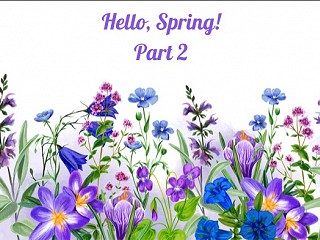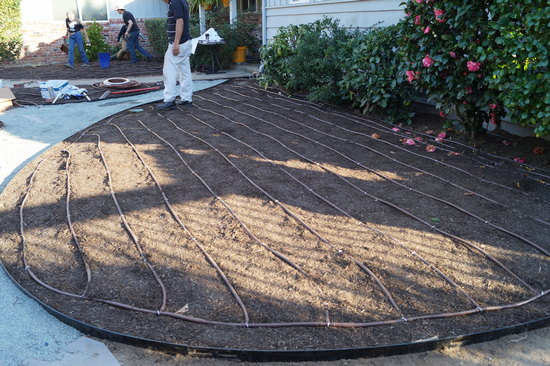Spring into Scheduling - Part 2 of 3

This is the second part of a three-part post on irrigation scheduling. Please go here to read part one.
As I said in part one of this post, I was asked by a survey respondent recently to talk about how to translate how much water each plant in the landscape needs … into irrigation timer settings. I explained a simple way to do this using online scheduling calculators that are web applications. This next part is dedicated to the deeper answer.
The Deeper Answer to: How Much Water?
You can certainly use the two calculators described previously to create your irrigation schedules. But if you’re intent on understanding the mechanics of irrigation scheduling, and how schedules are created, read on, my friend.
Let’s Clarify Drip Terms
Gail’s question about translating water needs of plants into irrigation timer settings was geared specifically toward line-source drip, or “Techline,” as she put it. Line-source drip, in case you’re unfamiliar with the term, refers to grids of inline emitter tubing. The emitters are built into the tubing, and the rows of the grid regularly spaced. Here’s a good photo to illustrate this in the real world.

Gail’s request has a bit of a twist to it. She wants to know how to translate the water requirement of individual plants to the irrigation controller’s schedule. But this type of drip doesn’t water individual plants; it waters areas. This can be a sticky concept to wrap your head around, as the water requirement, and thus the irrigation schedule, is measured in inches. But good news! This is actually convenient, and makes line-source drip easier to schedule than point-source drip.
What’s point-source drip? It’s the type of drip that uses individual emitters and other spot-watering devices to water individual plants. With point source, we water in gallons because the individual plant’s water requirement is in gallons in the U.S., whereas line source is measured in inches.
Since Gail asked specifically about Techline, which is a Netafim line-source product, I’ll stay the course of line source now, and close the book on point source for the sake of staying specific here. For the rest of this post, just know that I’m talking about the kind of drip in the photo above. If you’re confused by these two terms, I invite you to take my free online course called “Choosing a Drip Method” where I explain the difference between these two drip methods in such a way as to make it super clear. You can find this course at https://www.loripalmquist.com/
Irrigation Scheduling Formula
The formula we use for calculating the irrigation schedule for line-source drip is as follows:
Minutes per week = Weekly ETo x Plant Factor / Precipitation rate x 60
There are three factors that we need to look up to calculate this schedule:
- Weekly ETo (measured in inches) for the city the landscape is in
- Plant Factor (water-use value) of the plants in this irrigation zone
- Precipitation rate (also known as application rate) of the line-source drip for that zone. This is measured in inches per hour.
Weekly ETo - Where to Find This
If your site is in California, you’re in luck. I created a web application that lists the weekly historical ETo for every incorporated city in California for every month of the year. You can find this list at https://puddle-stompers.com/waterwonk/weekly_eto.php. If you’re not in California, check with your local university extension services or try a Google search on “current ETo data for [city or county and state].”
Plant Factor - Where to Find This
Once again, if your site is in California, I’ve got your back. I created another web application where you can look up the water-use value of landscape plants in California using the WUCOLS* list. You can find this at https://puddle-stompers.com/waterwonk/. If you’re not in California, seek references for plant water-use values for specific plants in your region.
Since this type of drip waters areas, you’ll want to determine what the water-use value of the area is. If there are mixed water uses in an irrigation zone, we designate the zone with the highest water-use value. But since we can’t plug a word like “low” into a formula, we need to assign numerical values to the words that describe water-use values. If you know generally the WUCOLS water-use value of the irrigation zone, go ahead and assign the following values:
- Very low water-use zone: 0.1
- Low water-use zone: 0.2
- Moderate water-use zone: 0.5
- High water-use zone: 0.8
Precipitation Rate - Where to Find This
First of all, let’s define precipitation rate. This is the rate at which the irrigation device applies water over a given area. It’s measured in inches per hour. It’s not like flow, which is measure in irrigation in either gallons per minute, or gallons per hour. Flow is the rate at which the water is dispensed from or through the irrigation device. Precipitation rate is the rate of the flow dispersed over an area.
This is the tricky part of the scheduling formula. In order to know the precipitation rate of the drip grids (line-source drip), you need to know the flow of an individual emitter, the emitter spacing on the tubing in inches, and the spacing of the rows in inches. The emitter spacing and the row spacing are easily measured. Finding the emitter flow can be challenging, however, if the tubing has been in place for a long time. These days, drip tubing manufacturers are getting better about marking their tubing indelibly, but this is a fairly recent change. I’ve seen lots of emitterline with no markings as to the flow rate.
If there are no markings on the tubing, there are a couple of things you can do. Jim Borneman with Ewing teaches how to get the gph of drip emitters by placing a 2-inch PVC cap beneath an emitter and then running the zone. The emitter flow is determined based on how long it takes to fill up the cap. I think this is brilliant! I wish I had been the one to discover this method. Here’s the guide: 2 minutes, 2 seconds: 0.92 gph (nominal rate is 0.9 gph) 3 minutes, 4 seconds: 0.61 gph (nominal rate is 0.6 gph) 4 minutes, 26 seconds: 0.42 gph (nominal rate is 0.4 gph)
If you don’t happen to have a 2-inch PVC cap lying around, here’s some guidance. If the emitterline tubing is black, it’s most likely 0.5 gph. I haven’t seen black emitterline tubing sold at any other rates of flow. (Please let me know if you’ve seen black tubing with any other flows than 0.5 gph.) If the tubing is brown, there are some distinct possibilities as to the flow rate. It could be either, 0.25 gph, 0.42 gph, 0.61 gph, 0.92 gph, or 1.0 gph. Since 0.25 gph is rarely used, I’d rule it out. The most common rates by far are 0.6 gph and 0.9 gph. These are the emitter flow rates most commonly stocked in the professional irrigation stores.
One thing you can do is go ahead and assume the flow rate is 0.9 gph. This way you can err on the side of too little water, rather than too much water. If you use this flow rate and see that the plants are not happy with your irrigation schedule, you can increase the run time to suit.
Once you’ve got the flow rate of an individual emitter, the way to get the precipitation rate for the grid is to plug the flow rate, the emitter spacing and the row spacing into the following formula:
[231.1 x emitter flow in gph] / [emitter spacing in inches x row spacing in inches]
Another way to get the precipitation rate is to look it up in the manufacturer’s product catalog for the product you’re using (if you know it). The manufacturers provide charts that tell you the precipitation rates for the different configurations that are possible. You do need to know the flow rate of the emitters for this, though.
Another method I’ve used is to start with a good “middle-of-the-road” precipitation rate, and see how the plants react to this. A good number for this is 0.8 in/hr.
Using the project shown in the photo above, we’ll go ahead and create our precipitation rate, based on those specifications. For that project, we used Hunter PLD emitterline tubing. The emitter flow rate was 0.4 gpm, the spacing of the emitters on the tubing was 12”, and the rows were spaced at 12”. Let’s plug those values into the run time formula.
Precipitation rate = [ 231.1 x 0.4 gph ] / [ 12” x 12” ]
Precipitation rate = [ 92.44 ] / [ 144 ] Precipitation rate = 0.64 in/hr
Let’s Generate the Irrigation Schedule
Once again, the formula for irrigation schedules is:
Minutes per week = Weekly ETo x Plant Factor / Precipitation rate x 60
Using the project in the photo, here are the values that would be filled into the formula for the irrigation zone in the photo, which was zone #3. We’ll create a schedule for the month of April. The weekly historical ETo for Lafayette, CA in April is 1.03 inches/week. The zone is moderate plants, so the plant factor value is 0.5. And the precipitation rate is 0.64 in/hr.
Minutes per week = 1.03 inches x 0.5 / 0.64 in/hr x 60 Minutes per week = 48 minutes
So we would run this irrigation zone for 48 minutes per week in April in Lafayette, California.
- WUCOLS is the Water Use Classification of Landscape Species, a plant-search database for landscapes in California.
Click here to read part 3.



06 May 2020 12:18:00
Oh my goodness — the detail so carefully spelled out. Lori — this is fabulous!
One thought — for the unpracticed…might want to ping how 231.1 became the precip rate.
[231.1 x emitter flow in gph] / [emitter spacing in inches x row spacing in inches]
06 May 2020 17:34:50
Pr – Precipitation rate in inches per hour. requires conversion factor 231. 1
1 gallon US per hour (gal/hr) = 231.00 cubic inches per hour (in3/hr)
07 May 2020 07:17:29
Hi Lori,
If you have sections of low water use plants and sections of moderate use plants in the same zone, would it make sense to use .4 gph emitter line in the former and .9 gph emitter line in the latter? Would that come closer to meeting plant water requirements with less waste and possible impact on plant health? Scheduling could be done using either set of numbers. Obviously it’s better to have similar water use plants in the same hydro ones but some zones are very small.
07 May 2020 07:40:00
Response to Ginny:
Thank you for the kudos!!!
And yes, a very good idea to explain where that constant of 231.1 comes from. Here’s what I’ve got in that department:
231.1 = 1 hour / 0.623 gal per sq. ft. inch x 144 inches in a sq. ft.
07 May 2020 07:48:35
Response to Dona:
Wow! Simple and elegant explanation of where 231.1 comes from! I love it!
07 May 2020 08:03:00
Response to John:
Yes! Absolutely! Your irrigation professor roots are showing! :-)
This would definitely work, and I feel like it’s an elegant solution to a tricky and all-pervasive challenge we have in our landscapes. But this would have to be impeccably documented as to exactly where the two different flows begin and end. Anybody who comes along later won’t understand what the heck’s going on, and may think there’s an issue when they see disparate flows in one zone.
There’s another factor that makes this challenge a bit murkier than it already is, and that’s SLIDE. If you were to look up the water-use values of the plants in an irrigation zone using SLIDE instead of WUCOLS, those plants would most likely be of the same water-use. What do we do with that, my friends?
If anybody reading this hasn’t heard of SLIDE, just Google “slide plant water use.” That will direct you to the UC ANR web page it lives on.
10 May 2020 15:23:13
Lori, Appreciate the insights on drip irrigation scheduling. Regarding precipitation rates with line-source drip, I see beauty and ease of PR= [231.1 x emitter flow in gph] / [emitter spacing in inches x row spacing in inches]. And this is great way to approach a new installation where product and layout are known.
However, I frequently have to deal with maintaining older systems where I have little knowledge of what exactly is in the ground. Because of variations in emitters, spacing, pressure, leaks, clogs, etc I do wonder if engineered answers to PR provide realistic way to go in this context.
10 May 2020 16:10:02
Hey John,
I have to say I totally agree with you on this. With new installations that are installed as specified, this scheduling approach is great. But as you say, with existing systems you just don’t know what you’re getting. I’m curious how you would handle scheduling such a situation.
I would be inclined to do a flow reading on the zone, and get the square footage, if possible. Then I’d plug this data into the gpm formula to calculate the best possible application rate. People often do this with point source. I know it’s a hack, but I think it’s better than nothing. :-)
26 May 2020 08:48:00
Yes, getting flow (GPM) at the meter/controller and dividing by zone FT2 generates an average Precipitation Rate (inches per hour). Out in the field, however, we find a big variation in empirical PRs. On face value, that would suggest varying the run times for different zones (e.g., fewer minutes for higher PR) holding all else constant. The varying PR, however, can also be an indicator of other issues that need to be resolved (e.g., leaks).
26 May 2020 09:03:00
Great input, John! I totally agree.
I’ve also found that these days, with the availability of real-time flow sensing data, it’s much easier to detect when something has gone amiss in an irrigation zone. I love being able to remotely check up on sites’ reports from certain smart controllers, and see when a zone has too high or too low flow, or if it’s not running at all, or if there is a mainline leak or break.
I know that on the higher end, this flow sensing has been around for a long time. And the flow sensor will even cause the system to shut down and send out alerts so it can be repaired quickly. But these systems have only fairly recently come available to smaller residential projects with lower budgets. I’m regularly amazed and excited by the powerful water-conserving features now available to all.